Choosing a hydraulic hose must be done with careful thought and consideration.
Contributed by Carl Dyke, CD Industrial Group, Inc.
With a new hydraulic machine design, or with a machine that has undergone a rebuild process, there comes the moment when it is time to specify and install the hoses that conduct fluid from point to point throughout the system.
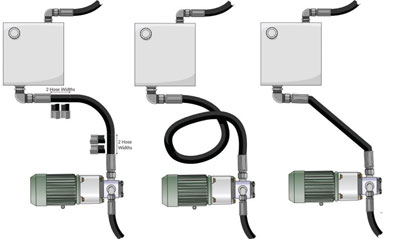
Make sure to leave at least two hose widths of space between the crimp and any bends when determining hose length. Here’s an example of a correct length, one that is too long and one that is much too short.
While the main functions of a machine and perhaps the most clever aspects of its design are likely contained within the mechanical works including the valves and actuators, the required hoses are not minor accessories. Careful thought and consideration are needed in order to make the best hose selection.
While inside diameter and the working pressure rating of a hose are typical factors to start with, outer diameter and the weight of a particular hose model are often critical on mobile machines.
A press in a factory setting or a mining drill maker may be quite concerned with the expected life of a hose as indicated by the pressure impulse cycle rating. Impulse cycles are sudden on-off pressures that cause stress to a hose. The test is typically conducted with pressure impulses at 133% of the working pressure rating. A rating of 200,000 cycles is considered minimal, with 1,000,000 cycle products available for those who wish to pay for them.
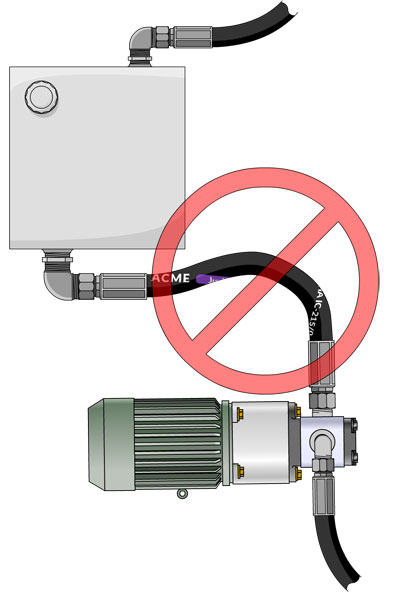
Don’t twist hydraulic hose. It severely compromises hose integrity.
Many readers might be accustomed to selecting a different hose product line for the larger diameter applications. Typically the working pressure decreases as the hose diameter gets larger within a single product line. A hose manufacturer may also offer a convenient single-pressure option where all diameters within a particular product line have the same working pressure rating.
The types of fittings to be used, the nature of the fluid, abrasion resistance, the flexing cycles of a hose and a range of installation challenges all add to the list of factors to be considered.
Objective information concerning the properties and construction of the common 100R-series hose can be found in the standard, SAE 517. Recommended Practices for Hydraulic Hose Assemblies, covered under SAE J1273, provides a wealth of advice on installation and on wear/maintenance issues. If you’ve seen Society of Automotive Engineers (SAE) approval markings on hoses and have wondered what they mean, simply purchase the matching standards and practices documents from the www.sae.org website. For those who work with ISO standards, similar documents are available from the ISO website.
Important words about safety
It shouldn’t need to be said that a hose burst failure is always a catastrophic incident. In the best case scenario, a hose failure might cause production downtime or environmental contamination concerns. In a worse scenario, persons could be seriously injured or even killed.
Using economics as the only or primary hose selection criteria can easily leave human risks at a very high level. A colleague recently contacted me regarding concerns about the pressure ratings of hydraulic hoses in use at the plant where he had just been hired on. He noticed that the normal system pressure was routinely at levels that were slightly higher than the working pressure rating of the hoses. Management assured him that with the known burst pressure rating for the hose at several multiples above the working pressure rating, there was no cause for concern and that the added expense for a higher rated hose was unnecessary. This is one example of a very poor hose selection process. In this case, safety was being neglected.
Never use hoses regardless of their age if you are aware of incidents of system overpressuring that have exceeded the normal working pressure. Cracked, blistered or abrasion worn hoses should never be put back into service.
What is “hose whip?”—Hose whip, (a shorter name for what happens if a hose or fitting breaks, and the hose then flails freely) can easily dismember or kill. Most hydraulic hoses are made up of layers of wire braid and include steel fittings on the end of the hose assembly. Imagine getting hit by a steel cable moving at high speed, and you’ll have an idea of the damage a hydraulic hose can do if it breaks away. In the case of a compressed fluid, the distance travelled and acceleration rate add to the carnage.
Correct selection for your application
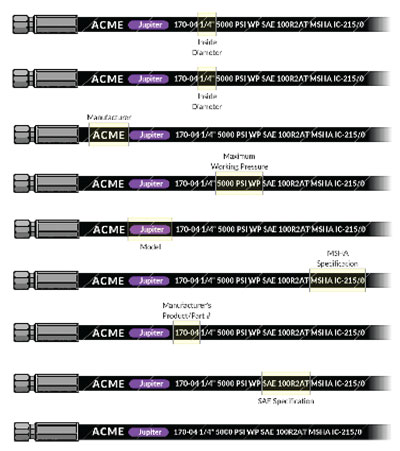
The hose layline should always include the maximum working pressure (WP). In addition, pertinent information such as inside diameter, manufacturer and model name, size, etc. can be found on the layline.
Whether you are replacing an existing hose, or building a new system, you’ll need to select a hose of the correct pressure rating, diameter, and length and with the best material properties for your application. Here are a few factors to consider carefully.
Pressure rating— A hose must be chosen with a maximum working pressure (WP) rating that is at or preferably above the normal maximum hydraulic system pressure. Momentary pressure surges for a hydraulic system are not to exceed this pressure rating. Hose fittings that are rated below the working pressure of the selected hose cause the entire hose assembly to be derated to the lower rating of the fittings.
Hoses typically become heavier for any given length, with added layers of reinforcing wire, as the working pressure requirement increases.
Many of the hose models in the common 100R series have lower working pressure ratings at the larger diameters. Often a -16 (1 in.) hose has a working pressure that half of the rating for the -8 (½ in.) hose in the same product line. This can be inconvenient and costly for a machine manufacturer. Look for SAE 100R17 series compact hoses to find a constant working pressure of approximately 3000 psi for all available diameters, or consider ISO 18752 rated hoses for a constant working pressure of approximately 4000 psi for all available diameters. Many of the ISO 18752 rated hoses also feature test impulse pressure cycle ratings of 500,000.
Burst pressure is a built-in safety factor for a hydraulic hose. A hose manufacturer verifies the burst pressure in a destructive test. The SAE standard J517 for the common series of 100R hydraulic hoses also categorizes leakage and also hose separation from hose fitting, as burst pressure failures. The hose does not have to violently break apart completely to have suffered a burst failure. The burst pressure rating of a hydraulic hose if often 4x the working pressure rating or greater.
Inside diameter—It’s very important to use a hose of the correct inside diameter. If the diameter is too small for a given rate of flow, the linear velocity will be too high. Excessive velocity will translate into friction and turbulence, which when combined will surely result in noticeably higher system pressure and heat.
Hose manufacturers typically supply a nomograph or a table that allows for the easy calculation of the optimum diameter for a given flow rate and hose length. Long hose lengths require a larger inner diameter to avoid excessive restriction and friction.
Length — Correct hose length needs to allow for bending and flexing as a machine moves and articulates, and to make sure that no undue stress is caused at the crimped fittings. A hose that connects in a perfectly straight path from one component to another may shrink in length up to 4% at maximum pressure. Allow this extra length when making up the hose assembly. An excessively long hose adds restriction to flow, increasing system pressure and reducing system efficiency.
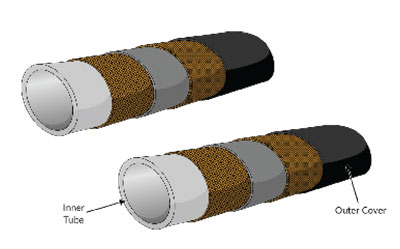
Our imaginary hose from Acme has 2 layers of reinforcing braided wire.
Material — Next, consider the conditions that a hose will operate under. The outer layer or cover of a hose can come in a variety of synthetic rubber materials. Some compositions can help with applications where abrasion may occur but may not bend as readily. Neoprene is one popular synthetic cover material that remains flexible across a wide range of temperatures, yet handles abrasion well. Most rubber hoses perform reasonably well from –40°C (–40°F) to 100°C (212°F). Look for the date of manufacture code on any rubber hydraulic hose that you are considering. The maximum shelf life is generally ten years at the most.
Where weight and space are a concern, as is often the case with mobile machines, look for hoses with a thin-wall inner tube. Advances in synthetic rubber compounds allow for higher wall strength allowing for a final product with a smaller outside diameter. Some manufacturers have moved to a reinforcement wire with an oval cross-section as opposed to round, offering additional outside diameter (O.D.) and hose weight savings. These smaller O.D. hoses, referred to as compact models in many catalogs, also offer much tighter bend radiuses.
Thermoplastic hoses are generally much lighter than rubber hoses. The inner tube of copolyester or nylon is typically braided or spiral wrapped with a synthetic reinforcement fiber instead of steel. Synthetic fiber is also needed for electrically non-conductive (orange cover), aerial lift hoses. In many cases the outer cover of thermoplastic hoses will be polyurethane and provide a longer shelf life than rubber, better flexibility at low temperatures such as –60°C (–75°F), and higher resistance to UV and chemicals.
Thermoplastic hoses are not always available for diameters above once inch.
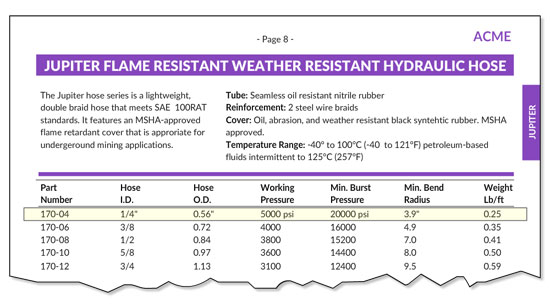
Use the hose layline to access the full hose specifications from the manufacturer’s catalog.
Hose laylines — Hoses should have their part number, pressure rating, and size stamped along the outer cover. Industry standards and approvals will also be shown. They may also display manufacturer-specific information, such as the trade name of the specific product line. Different manufacturers will have slightly different ways of presenting this information. This strip of information is called the layline.
Let’s decode this generic layline shown in the pictures.
Section by section:
- ACME = Manufacturer
- Jupiter = Hose Model
- 170-04 = Manufacturer’s Product/Part Number (Note: dash size -04 denotes the inside diameter in 1/16″ increments, ie. 4/16″ or ¼”)
- ¼” = Inside Diameter in Inches
- 5000 PSI WP = Maximum Working Pressure
- SAE 100R2AT = SAE (Society of Automotive Engineers) specification for a hose with two layers of reinforcement wire.
- MSHA IC-215/0 MSHA (Mine Safety and Health Administration) approval
Information is not always presented in the same order. However, you should always find the maximum working pressure, the size, and the hose product number. The product number can be used to gather other information you’ll need from the manufacturer’s catalog and website.
Ensure proper installation
So now that you’ve selected the correct hose, let’s talk about best practices for installing it.
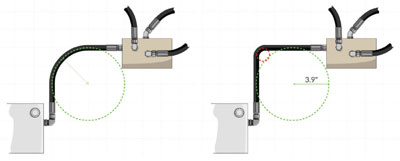
The first hose is making too tight of a corner (represented by the red circle.) The green circle indicates the minimum bend radius allowed for this hose. The second hose is correct.
Minimum bend radius — You’ll find the minimum radius for a hose in the product catalog. This refers to the arc that the hose follows in order to prevent restriction, damage due to kinking. Bends should not begin immediately after the hose end fitting.
For example, the manufacturer’s catalog tells us that our hose has a minimum bend radius of 3.9 in. Let’s look at what this really means.
Plan out the hose path to avoid tight bends. This will improve the life of your hose, and it will promote laminar (straight) flow inside of the hose. Turbulence from excessively tight bends can cause the inner tube to become eroded and damaged.
Bending and twisting — Twisting is a very serious stress that can lead to failure on most any hydraulic hose. Prevent twisting of the hose as it is installed between two ports or fittings. Pay attention to the layline to make sure that is not spiralling around the hose, as you tighten fittings. The use of fittings with swivels also helps in this regard.
A hose that actively bends in two or three planes during machine motion may produce stresses and twisting that dramatically shorten hose life. Work towards single plane bends as much as possible.
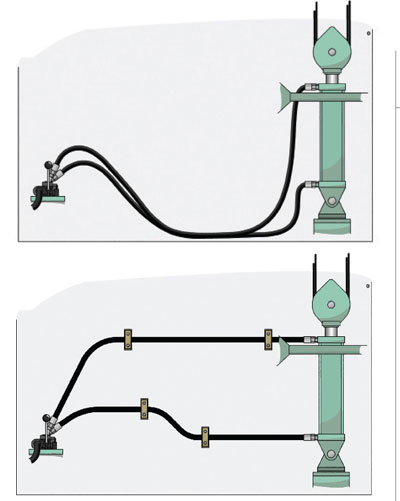
Support hoses to avoid stress on fittings, eliminate trip hazards, and prevent flailing when the hose pressurizes and contracts.
Brackets/support — For lengthy hydraulic hoses you may need to install brackets or another method of support. Don’t rely on the fittings to hold a hose in the correct position. Install brackets or other means of support as necessary.
Cleanliness — New rubber hoses need to be cleaned after they are sawn to length. Cleaning projectiles and the hands tools (guns) that propel the projectiles through the hose are more affordable than ever and pay for themselves quickly. With particle contaminants clearly identified as the leading cause of hydraulic valve malfunctions, the days of cut-and-crimp should be behind us. A freshly cut length of hydraulic hose has rubber and also metal wire particles within it. It is the sawing process that produces these particles. It takes only thirty seconds in most cases to complete the hose cleaning process before crimping the fittings onto the hose end.
Thermoplastic hoses are cleaner from the start as they are cut/sheared to length as opposed to being sawn to length.
Conclusion
Using a hose with a working pressure rating that is too low is a very serious safety concern. Always err on the side of caution by choosing a hose with a working pressure rating that provides a safety margin. Burst pressure ratings should never be used to deliberately allow a system to work above the working pressure rating. If you are concerned about pressure surges, look for hoses with a high impulse cycle rating.
When choosing a hose you should consider the pressure rating, temperature range, cover material and bend diameter among other factors. Before assembling a rubber hydraulic hose, clean it internally! Use brackets and supports wherever required to maintain the best hose position, and to avoid unnecessary flexing. Ensure that the hose is never forced into a tighter bend than the minimum radius allowed. Consider thermoplastic hoses for lightweight options and for tighter than normal bend radiuses.
Finally, if you are not sure how to objectively sort through the information provided by a sales rep, purchase and read the standards documents (SAE, ISO, ANSI, DIN etc.) for the types of hoses you are considering.
CD Industrial Group
carldyke.com
LunchBoxSessions.com
Filed Under: Hose Assembly Tips
